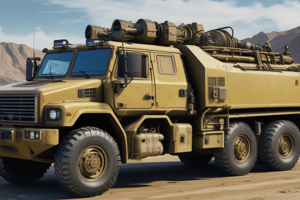Podcast
Questions and Answers
The space your vehicle fills on the road is called which of the following?
The space your vehicle fills on the road is called which of the following?
- Road Occupancy
- Vehicle Safety Zone
- Driving Space
- Vehicle Operating Space (correct)
In order to safely manage the space between your vehicle and the others around you, how much space should you maintain behind your vehicle?
In order to safely manage the space between your vehicle and the others around you, how much space should you maintain behind your vehicle?
two car lengths
Which of the following best describes why you need to maintain open space cushions?
Which of the following best describes why you need to maintain open space cushions?
- Improves vehicle aesthetics
- Increases fuel efficiency
- Reduces tire wear
- You might need to brake unexpectedly (correct)
With no restrictions to your line of sight, how far ahead should you be able to see on the road?
With no restrictions to your line of sight, how far ahead should you be able to see on the road?
How far behind the vehicle ahead of you should you remain?
How far behind the vehicle ahead of you should you remain?
At 30 MPH, it takes ___ feet to stop a vehicle.
At 30 MPH, it takes ___ feet to stop a vehicle.
If you stop your car at 30 MPH, how far will your car travel from the time you hit the brakes until you come to a complete stop?
If you stop your car at 30 MPH, how far will your car travel from the time you hit the brakes until you come to a complete stop?
Lane 2 position is which of the following?
Lane 2 position is which of the following?
Which of the following is the deadliest vehicle accident?
Which of the following is the deadliest vehicle accident?
Which position describes when a vehicle is placed to the right and over the lane dividing line?
Which position describes when a vehicle is placed to the right and over the lane dividing line?
Flashcards are hidden until you start studying
Study Notes
Vehicle Operating Space
- The space occupied by a vehicle on the road is called the "Vehicle Operating Space."
Maintaining Safe Distances
- It’s recommended to keep a distance of two car lengths behind your vehicle to safely manage space relative to others.
- Maintain a gap of 3 seconds from the vehicle ahead to ensure adequate reaction time.
Importance of Space Cushions
- Open space cushions are essential as they provide the necessary margin to brake unexpectedly if required.
Visibility on the Road
- Ideally, you should be able to see 20-30 seconds ahead on the road without any obstructions to maintain awareness of potential hazards.
Stopping Distances
- At a speed of 30 MPH, it requires approximately 80 feet to bring a vehicle to a complete stop.
- Once brakes are applied at 30 MPH, a vehicle can travel around 88 feet before it stops completely.
Lane Positions
- Lane 2 position refers to being 6 inches from the center dividing line of the lane.
- Lane 4 position indicates a vehicle is positioned to the right and crossing over the lane dividing line.
Collision Types
- Head-on collisions are classified as the deadliest type of vehicular accident.
Studying That Suits You
Use AI to generate personalized quizzes and flashcards to suit your learning preferences.



